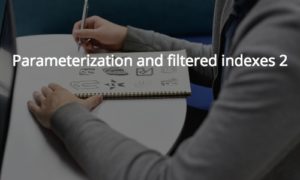When I started this blog, my plan was to focus on two main subject areas. One of them is SQL Server, T-SQL, and performance. The other is database design.
Looking back over my post history, I honestly cannot say I delivered on the second area. Not because I have nothing to say about database design, but because I found it doesn’t lend itself for a blog. In the SQL Server / T-SQL area, there are subjects that can be isolated and described in a single post, or in a short series. In database design, I do not see such objects. Everything is related, and the only good way to cover this is end to end – starting at requirements gathering, through modeling, normalization, more normalization, and ending at the final database design.
That cannot be covered on a blog post. So I found a different place: Pluralsight. Pluralsight is a company that provides online training on IT-related subjects. Excellent training, delivered by the best specialists available, for a fraction of the price of classroom training. And with the additional benefit of being able to pause and rewind as often as you want.
Relational Database Design
I was delighted when Pluralsight offered me the opportunity to record a course on relational database design for them. I must admit that creating the course took more time than I had ever anticipated – but it is now finished and available in the Pluralsight course library. It is a very comprehensive course – to see the entire course, end to end, you will need to set aside almost a full work day: 7 hours en 33 minutes. But luckily, you can consume the course in small portions, watching a few clips when you have time and stopping to return later when you’ve had enough.
The first module is the introduction, in which I give a historic overview of how storage hardware and methods have evolved to where they are now. If you are pressed for time, you might consider skipping this module. Knowing the past can help understand the present better, but this module is not required to understand the rest of the course.
In module 2, I explain the IDEF1X notation for ER diagrams, that I use throughout the course. Module 3 presents you with techniques you can use to gather the information you need from the domain experts, and module 4 shows how to use that information to create a first draft of the data model. Module 5 then explains how to convert between the ER diagram and the relational database representation of the data model – I personally prefer to postpone this conversion until after the normalization, but not everyone likes to work that way; hence my decision to cover the conversion first.
Normalization is a subject that is far more complex than many people realize – yet much easier to do than many people fear. I use two (long!) modules to cover basic normalization, up to third normal form; and then a third long module to go over all the so-called “higher” normal forms – often considered to be unnecessary, too hard to do, and too complex to understand. I hope you’ll disagree with those qualifications as much as I do after watching this module.
IDEF1X may be popular, it is far from the only ER diagramming method. In the last module, I cover several other methods, showing you how much they are alike and where you’ll find the important differences. After seeing it, you should be able to work in any ER diagramming method you may encounter.
I personally think that this is a very good course on relational database design. But I might be just a bit biased. So I suggest that you go ahead, check it out, and be your own judge!
Cheap …
My relational database design course is not only (in my opinion) very good – it is also extremely affordable. Have you ever looked at the cost of a classroom course on database design, then decided that you simply cannot afford it? The good news is – Pluralsight is cheaper! Prices for individual subscriptions start at just $29 per month, or $299 per year for a basic subscription – which already gives unlimited access to the full course library. Or you can pay $49 per month / $499 per year for a “plus” subscription, that adds access to exercise files, assessments, certificates, and offline viewing.
And for that low price, you do not get access to just my course on relational database design – the full course library of Pluralsight already contains over a thousand titles, with new titles being added almost every day. Readers of this bog should be excited to see over fifty courses in the SQL Server subject area, by renown experts such as Paul Randal, Jonathan Kehayias, Leonard Lobel, Glenn Berry, and many others. And if you want to look beyond the borders of SQL Server, Pluralsight has courses on almost every other subject (as long as it is related to dev and IT).
… or free?
But the title of my blog promises “free”, not “cheap”. Thirty bucks per month may be a steal, but it is not free. Was I lying? Of course not! You can check my relational database design course (and more) for free. How? Simple!
Method 1: available to all, but a bit limited. Go to the Pluralsight website, and sign up for a free trial. This costs you absolutely nothing, and it gives you access to all the Pluralsight courses for a whole week. There is a catch, though – your viewing time is limited to 200 minutes. So you can use the trial to watch one of the shorter courses completely, to get a very extensive taster of a longer course, or to browse around and watch snippets of many courses – that is up to you!
Using this method is an easy way to watch almost half of the relational database design course for free. But what about the rest? Enter method 2!
Method 2: sufficient to watch the entire course, but not available to everyone. Pluralsight has allowed me to give out a few one-week training passes. Like the free trial, these give access to all courses in the course library, for a full week. Unlike the free trial, they are not time limited. If you have the stamina, you can get a whole 168 hours of training out of them. (I do not advise this. I am not responsible for the effects on mental and physical health if anyone thinks they should even try this. Please don’t). But with a bit of planning, a week should be enough to consume the entire relational database design course, and still have time left to check out some of the other courses!
So how do you get such a free pass? The easiest method is to post a comment to this blog, explaining why I should pick you. On February 10, I will choose the five best, most convincing, or maybe just the funniest comments, and reward them with a training pass!
So go the the Pluralsight site, sign up for that free trial, check out my course, then return here and post a comment. Convince me!



7 Comments. Leave new
;WITH XMLNAMESPACES
(‘http://schemas.microsoft.com/sqlserver/2014/01/PluralsightFreePass/‘ AS ns)
SELECT EmailAddress
FROM dbo.YourHat
WHERE UserName = ‘FrancescoQuaratino’
AND Personality.exist(‘(/ns:Interest/ns:DBMS[.="MS SQL Server"])’)=1
Hi Francesco, thanks for the opportunity to stand a chance to win a free pass.
I am the only one looking after the databases in our company and have had to learn everything on my own. I have formulated a 3 phase strategy:
Configuration of servers and admin. This I have done after doing much reading on blogs as to best practices (Brent Ozar, Paul Randall and the like).
Index optimization.
T-SQL best practices and database design.
I am at the point of completing the first two phases and am about to embark on phase 3, however as I have mentioned, the training is all self-taught.
Being in South Africa, unfortunately the exchange rate of Rand to Dollar has hit a 5 year low. As of this writing stands at 11.27 Rands to the USD, so has made self study prohibitive.
It would be much appreciated if you could consider my request.
Many thanks,
Nico.
A starting new bie with no budget to afford the training.
May be a learning pass from a good samaritan can help me learn the excellent in depth concepts of database design by an expert.
it a great opportunity for me to learn
Thanks,
Antonello
The act, process, or experience of gaining knowledge or skill.
This is learning!!!
I waited a few extra days to see if there would be more entries – but I now really have to announce the winners.
With five prizes to give away and five entrants, the decision was very easy. Each of the five entrants wins.
Franseco, Nico, Jagannath, Antonelle, and Pasquale: Congratulations!
Please contact me (you can use the "Email" link in the upper right part of the screen) so that I can send you your one-week Pluralsoght pass.
i want to know more about T-SQL area. plz give me a detail